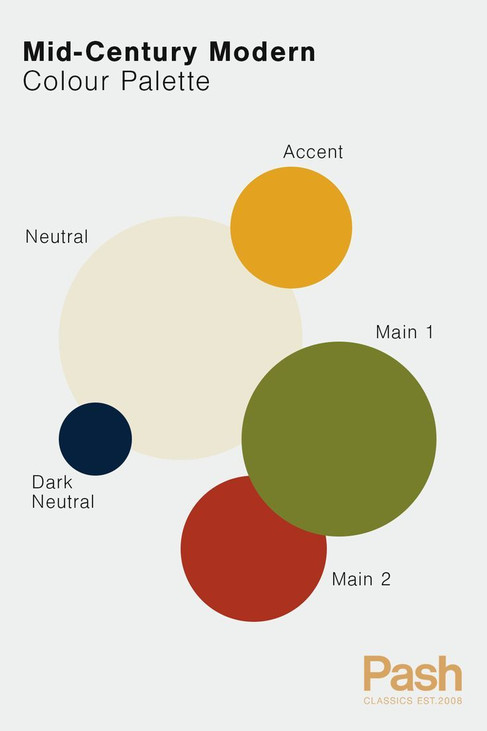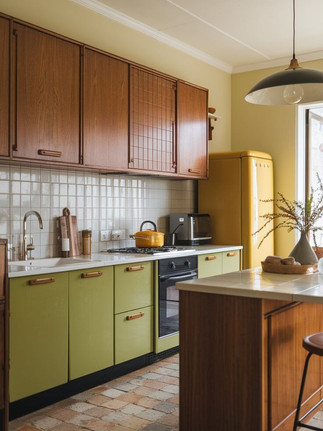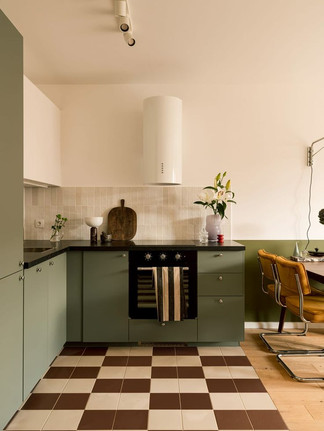Mid-century and everything you have to know about
- Beatrice Bodasca

- Apr 4
- 5 min read
If you want to add a retro touch of your interior, here is everything you need to know about and how to do it without making too much.
What is retro or mid-century style?
The term "mid-century" generally refers to a period in history, primarily in design, architecture, and culture, spanning the 1940s to the 1960s.
The term "mid-century" literally means "middle of the century," and is primarily used to refer to a particular style that emerged during the mid-20th century.
Here are some defining elements of the "mid-century" style:
Architecture: Mid-century homes and buildings are often known for their clean lines, open spaces, the use of large windows, and harmonious integration with the exterior environment. Mid-century modern emphasizes functionality, simplicity, and the use of materials such as concrete, glass, and wood.
Interior Design: Mid-century furniture and objects are often minimalist, with clean lines and geometric shapes. Bold colors, vinyl and plastic fabrics, and stainless steel were popular. This style embodies an aesthetic of modernity and innovation, often associated with designers such as Charles and Ray Eames, Eero Saarinen, and George Nelson.
Culture: In a cultural context, the mid-century modern movement is also linked to post-war optimism, the rise of mass consumption, and the expansion of suburbs, particularly in the United States. This marked a time of technological transformation and social change.
The mid-century modern style remains highly regarded and influential in design today, particularly in decorative objects, furniture, and contemporary architecture.

In the United States, during the post-war boom, people craved novelty, and this freedom allowed for more experimentation with new styles and materials.
In Europe, modernism found its roots primarily in France and Italy. European modernist designers such as Gio Ponti, Ico and Luisa Parisi, Jean Royère, and Max Ingrand produced some of the most representative pieces of modern design.
The most beautiful interiors are often designed around a few beautiful pieces of furniture, which aren't flashy, but rather an open and comfortable space. As for the main furniture, it's usually limited to a sofa, two armchairs, a sideboard, a coffee table, and a few stools. Warm wood tones (teak, walnut), well-placed footstools, and good lighting create the perfect setting for a pleasant moment.
To give the room character and personality, shelves filled with books and other interesting objects are often used, providing a source of texture and color.

How to create a mid-century style at home? How it was used to be and tips to integrate a retro touch in your deco :
Creating a mid-century style at home can truly transform a space by bringing a touch of modernity, simplicity, and functionality. Here are some tips for adopting this style in your home:
1. Colors
Color Palette: Mid-century modern style uses a palette of bright, contrasting colors. Think hues like burnt orange, turquoise blue, olive green, mustard yellow, and bright red, often paired with neutral tones like white, gray, or beige.
Contrasts: Background colors should be muted, with pops of brighter colors for accessories and decorative objects.
TIPS:
Use soft, pastel shades like powder blue and mint green, or warmer colors like burnt orange, mustard yellow, or cherry red. These colors are often associated with retro decor from the 60s and 70s.
Geometric Patterned Rugs: Vintage geometric patterns, stripes, or florals are a great way to evoke the aesthetics of decades past.
2. Furniture
Clean lines: Opt for furniture with simple, geometric, and functional lines. Chairs and tables with tapered wooden legs are typical of the mid-century style.
Materials: Wood (especially teak, mahogany, and oak) is a key material often used for furniture. It can be combined with modern materials such as metal, glass, and molded plastic.
Armchairs and sofas: Choose sofas with a low silhouette, fabric or leather cushions, and slightly retro colors. Armchairs with thin, slightly slanted legs are also characteristic of this style.
A sofa or armchair in pastel-colored velvet or slightly distressed leather can really enhance the retro feel.

TIPS: Opt for solid wood furniture, preferably in warm tones reminiscent of the 50s and 60s. Furniture with a simple, functional yet elegant design, such as ladder-shaped chairs or fabric armchairs with geometric patterns, will add that retro feel.
3. Accessories and Decorations
Lighting: Mid-century lamps are often sculptural and graphic, with metal or fabric shades. Floor lamps, such as tripod lamps, are also typical.
Wall Art: Vintage posters, geometric, or abstract pieces can complete the ambiance. Clocks with simple, modern shapes are also popular.
Rugs and Textiles: Choose rugs with geometric patterns or bright colors. Curtains should be lightweight and in neutral or natural shades.
TIPS : Look for floor lamps with cone-shaped shades or metal pendants. Filament bulbs can also add a touch of vintage charm. A mirror with a decorative frame in an art deco style or geometric shapes typical of the 1970s adds a lot of character to the room.
You can hang posters from iconic movies from the 50s, 60s, or 70s, or even retro advertisements for iconic products from that era.
Using illustrations or paintings depicting typical scenes from those eras (classic vehicles, vintage landscapes) can also add a touch of nostalgia.
You can incorporate retro appliances like a pastel refrigerator or a vintage toaster.
If you have the space, an old TV or radio from the 60s and 70s can really complete the retro feel.
Choose ceramic pots or colorful planters, and add a few green plants like ferns or cacti to complete the retro feel.

4. Materials
Wood: Wood is a key material. Choose solid wood furniture or light wood finishes (oak, walnut).
Metal: Metal elements (often chrome or brass) are used in furniture legs, lighting, and some accessories.
Glass: Glass coffee tables or hanging glass and metal shelves add a modern touch to the space.

5. Layout and Open Spaces
Open Spaces: Mid-century modern design favors open and functional spaces. Rooms are often arranged to promote circulation and leave room for space-saving furniture.
Outdoor Integration: Whenever possible, incorporate elements that open to the outdoors, such as large windows and French doors.
6. Mid-Century Design Icons
Eames Chairs: A lounge chair by Charles and Ray Eames is a must-have piece in a mid-century interior.
Saarinen Tables and Chairs: The Tulip Table and Tulip Chairs by Eero Saarinen are classics of mid-century design.
Modular Shelving: Open, modular shelving is also a signature of this style.
7. Mix with contemporary elements
Although mid-century style is retro, you can also integrate it with contemporary elements. For example, mix a vintage sofa with modern pieces to avoid a look that's too rigid or overly thematic.
8. Minimalism
Less is more: Mid-century style is often characterized by its simplicity and lack of excess. It favors functional and elegant objects over clutter. Avoid overly bulky furniture and unnecessary accessories.
Example of a typical mid-century room:
A living room could feature a simple sofa in gray or blue fabric, leather or wooden armchairs with slim legs, a wood and glass coffee table, a geometric patterned rug, a modern floor lamp, abstract paintings on the walls, and a vintage wooden TV stand.
By following these principles, you can create an interior that captures the spirit of the mid-century style while adding your own personal touch.






























Comments